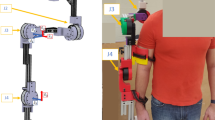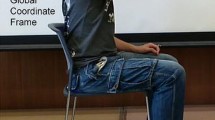Abstract
This article presents a biomechanical model of the right arm, developped with respect to the functional anatomy of the human. This model is developped as a motion analysis tool. The main application issued from this model is the muscle forces estimation of the flexion/extension and internal rotation of the forearm joints. This estimation is based on an inverse dynamics method, improved with additionnal constraints such as co-contraction factor between flexors and extensors of a joint. The article first presents the related work, then presents the biomechanical model developed, and at last some results obtained for a sample movement of the arm.
Preview
Unable to display preview. Download preview PDF.
Similar content being viewed by others
References
Aptel, M., Aublet-Cuvelier, A.: Prévenir les troubles musculosquelettiques du membre supérieur: un enjeu social et économique. Santé Publique 17(3), 455–469 (2005)
Bidault, F., Chablat, D., Chedmail, P., Pino, L.: Distributed approach for access and visibility task under ergonomic constraints with a manikin in a virtual reality environment. In: Proceedings of 10th IEEE International Workshop on Robot and Human Communication, pp. 32–37 (2001)
Ma, L., Chablat, D., Bennis, F., Zhang, W., Guillaume, F.: A new muscle fatigue and recovery model and its ergonomics application in human simulation. In: Proceedings of IDMME Virtual Concept, pp. 1–10 (2008)
Delp, S.L., Anderson, F.C., Arnold, A.S., Loan, P., Habib, A., John, C.T., Guendelman, E., Thelen, D.G.: OpenSim: Open-Source software to create and analyze dynamic simulations of movement biomedical engineering. IEEE Transactions 54, 1940–1950 (2007)
Holzbaur, R.S., Katherine, M.M., Wendy, D.S.L.: A model of the upper extremity for simulating musculoskeletal surgery and analyzing neuromuscular control. Annals of Biomedical Engineering 33, 829–840 (2005)
Yamane, K., Fujita, Y., Nakamura, Y.: Estimation of physically and physiologically valid somatosensory information. In: Proceedings of the 2005 IEEE International Conference on Robotics and Automation, pp. 2624–2630 (2005)
Chalfoun, J.: Prédiction des efforts musculaires dans le système main avant-bras: Modélisation, simulation, optimisation et validation. PhD thesis, Université de Versailles Saint-Quentin en Yvelines (2005)
Maurel, W., Thalmann, D.: A Case Study Analysis on Human Upper Limb Modelling for Dynamic Simulation. Computer Methods in Biomechanics and Biomechanical Engineering 2(1), 65–82 (1999)
Buchanan, T.S., Loyd, D.G., Manal, K., Besier, T.F.: Neuromusculoskeletal Modeling: Estimation of Muscle Forces and Joints Moments and Movements From Measurements of Neural Command. Journal of Applied Biomechanics 20, 367 (2004)
Zajac, F.E.: Muscle and tendon: properties, models, scaling, and application to biomechanics and motor control. Critical Reviews in Biomedical Engineering 17, 359–411 (1989)
Moore, K.L., Dalley, A.F.: Clinically Oriented Anatomy, 4th edn. Lippincot Williams Wilkin (1999)
De Leva, P.: Adjustments to Zatsiorsky-Seluyanovs segment inertia parameters. Journal of Biomechanics 29, 1223–1230 (1996)
Pronost, M., Dumont, G.: Dynamics-based analysis and synthesis of human locomotion. The Visual Computer, 23 (2007)
Copyright ©2001 University of Brussels (ULB), http://www.ulb.ac.be/project/vakhum
Challis, H.J.: Producing physiologically realistic individual muscle force estimations by imposing constraints when using optimization techniques. Med. Eng. Phys. 19, 253–261 (1997)
Pontonnier, C., Dumont, G.: From Motion Capture to Muscle Forces in Human Elbow Aiming at Improving Ergonomics of Working Stations. In: Proceedings of IDMME Virtual Concept, pp. 1–10 (2008)
von Konsky, B.R., Zomlefer, M.R.: The sensitivity of upper limb muscle moments to variation in physiological cross-sectional area. In: Proceedings of the 18th Annual International Conference of the IEEE Bridging Disciplines for Biomedicine, vol. 5, pp. 2242–2243 (1996)
Pontonnier, C., Dumont, G.: Inverse Dynamics Methods Using Optimization Techniques for the Estimation of Muscle Forces Involved in the Elbow Motion. International Journal on Interactive Design and Manufacturing 78 (2009)
Author information
Authors and Affiliations
Editor information
Editors and Affiliations
Rights and permissions
Copyright information
© 2009 Springer-Verlag Berlin Heidelberg
About this paper
Cite this paper
Pontonnier, C., Dumont, G. (2009). Motion Analysis of the Arm Based on Functional Anatomy. In: Magnenat-Thalmann, N. (eds) Modelling the Physiological Human. 3DPH 2009. Lecture Notes in Computer Science, vol 5903. Springer, Berlin, Heidelberg. https://doi.org/10.1007/978-3-642-10470-1_12
Download citation
DOI: https://doi.org/10.1007/978-3-642-10470-1_12
Publisher Name: Springer, Berlin, Heidelberg
Print ISBN: 978-3-642-10468-8
Online ISBN: 978-3-642-10470-1
eBook Packages: Computer ScienceComputer Science (R0)




